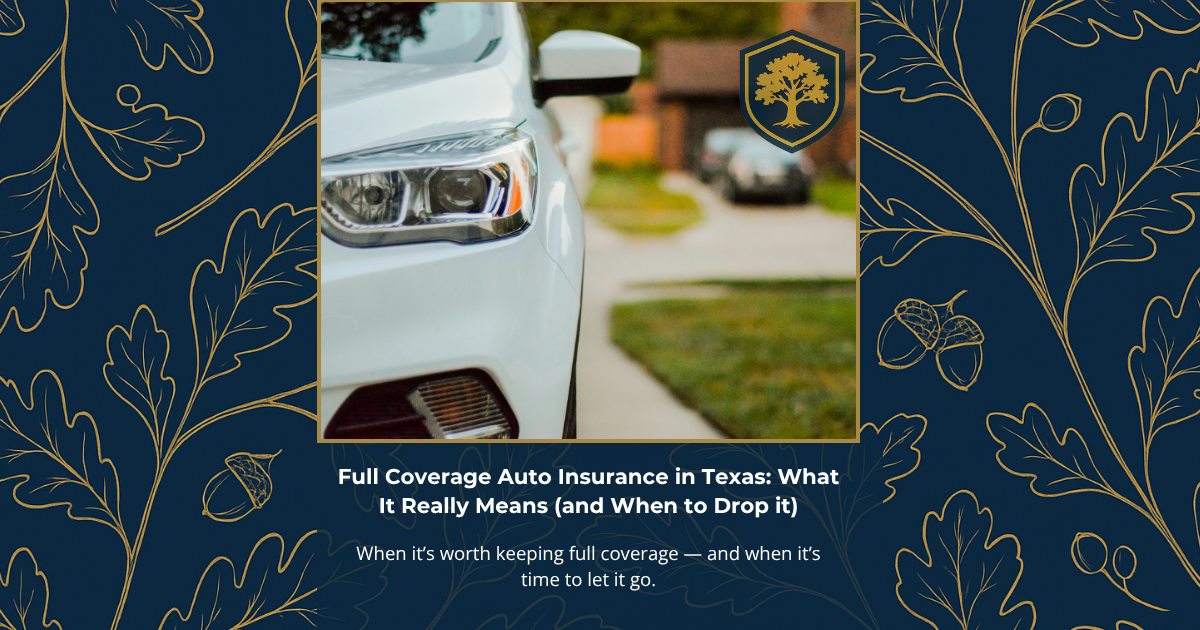Most Texans say they have “full coverage,” but what does that actually mean?
Here’s the truth: “Full coverage” isn’t an official insurance term — it’s just a common phrase people use when their policy includes Comprehensive (sometimes called Other-Than-Collision) and Collision coverage in addition to the required liability insurance.
Understanding what full coverage really includes can help you decide whether it’s still worth keeping, especially as your car ages or your needs change.
What “Full Coverage” Really Means (and Why It’s a Misleading Term)
When drivers in Texas ask for “full coverage,” they typically want protection for their own vehicle — not just for damages they might cause others. That means adding Comprehensive and Collision coverage to their policy.
Here’s a quick breakdown:
- Collision coverage helps pay to repair or replace your vehicle if it’s damaged in an accident with another vehicle or object — regardless of who’s at fault.
- Comprehensive coverage (Other-Than-Collision) covers damage from things other than a wreck: theft, fire, hail, vandalism, falling trees, hitting an animal, etc.
Together, these two coverages help protect your own vehicle — not just other drivers.
When It Might Be Time to Re-Evaluate “Full Coverage”
As vehicles age, their actual cash value (ACV) — the amount an insurer would pay if the car were totaled — goes down. Once your vehicle’s value dips below a certain point, the cost of maintaining both comprehensive and collision coverage can outweigh the potential payout.
A good rule of thumb:
Once your car reaches around 10 years old, or its market value is under $8,000–$10,000, it may be worth having a conversation with your insurance agent.
That doesn’t automatically mean you should drop the coverage — but it’s the right time to re-evaluate.
💡 Why Some Drivers Still Need Full Coverage
For many Texans, the decision isn’t just about math — it’s about financial readiness.
If your vehicle were totaled and you didn’t have enough savings for a new down payment, the lump sum payoutfrom comprehensive or collision coverage could be the difference between getting back on the road quickly or being stuck without transportation.
Even if your car’s actual cash value isn’t very high, that payout can help bridge the gap until you’re financially ready to replace your vehicle.
In short:
- If losing your car tomorrow would put you in a bind, keeping full coverage might still be the right call — even on an older vehicle.
- If you have an emergency fund or enough savings to replace your car, you might be in a position to safely drop it.
This is one of those gray areas where your personal finances matter more than your car’s age alone.
A Quick Math Example
Let’s say your car is worth about $10,000, and dropping full coverage saves you between $50–$100 per month.
- At $50/month, that’s $600 per year in savings.
- At $100/month, that’s $1,200 per year.
If you go five years without an accident or claim, you’ll have saved between $3,000–$6,000 in premiums — without ever needing that coverage.
However, if your vehicle were totaled in that time, the most you could receive from a claim (after your deductible) might only be around $9,000–$9,500. So depending on your risk tolerance, driving habits, and budget, either choice could make sense.
Other Factors to Consider
Dropping comprehensive or collision coverage shouldn’t be a quick decision. Consider these key factors:
- Your driving history: If you’ve had accidents or frequent claims, keeping the coverage might still make sense.
- Your financial cushion: Could you replace your vehicle or make repairs out-of-pocket if something happened?
- Your age and overall risk profile: Younger drivers or commuters with long drives may have higher exposure to risk.
The Bottom Line: Talk With a Licensed Agent Before Deciding
There’s no one-size-fits-all answer. The right decision depends on your vehicle’s value, your financial comfort, and your personal risk tolerance.
Before you make changes to your policy, it’s always a good idea to talk through the numbers with an experienced, licensed insurance agent who can help you compare what you’d actually save versus what you’d risk losing.
At Gilded Oak Insurance, we help Texans make confident coverage decisions — not guesses.
Click below to start your free coverage review and find out if “full coverage” still makes sense for you.
Get Your Free Coverage Review →
⚜️ Stay Connected with Gilded Oak
Join us on social for insurance savings tips, light-hearted entertainment, and everyday insights that make coverage easier (and a little more fun) to understand.
Request a Quote


